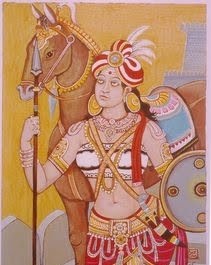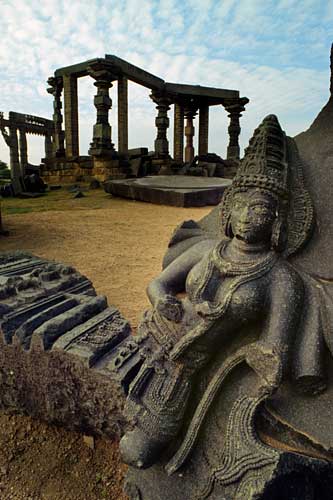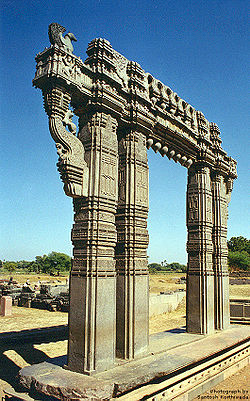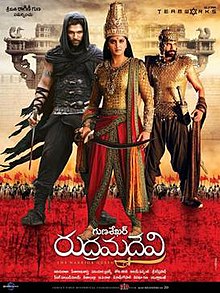Rani Rudrama Devi - The Brave Queen Of Medieval Kaktiya Empire- Her Life and videos
 |
| Rani Rudrama Devi |
The perception of the history of the past has often been primarily from male point of view. That’s why it is called “His”tory rather than “her”story or “their”story. Isn’t it? Generally all the historical writings relegated women to background. The activities of men are mostly projected while that of women were ignored and were almost neglected. The administrative abilities of women generally never surface in the history pages. So here I present the life of a Medieval Queen of Deccan - Rani Rudrama Devi.
Rani Rudrama Devi 1259 to 1289 AD was one of the most prominent rulers of the Kakatiya dynasty on the Deccan Plateau, being one of the few ruling queens in Indian history. She shines gloriously in the medieval history of South India. She was the only child of King Ganapathi Dava who ruled at Warangal the capital of Kakateeya Dynasty that had sway over entire Telangana ( Present Andhra Pradesh State) and most of the Andhra provinces during 13 th century.
Kakatiyas of Warangal are one of the major dynasties that ruled over Andhra and shaped its history and civilization. The foundation of kakatiya empire was laid in land lying between Godavari and Krishan on a hillock called Hanumakonda. The Story of the builders of the empire goes back to the eight and ninth centuries of Christian Era. With Orugallu(now known as Warangal) as their capital the kaktiyas ruled over the Telugu country from about 1150 AD to 1323 AD.
Coronation
 |
| The Remnants of the Warangal Fort |
 |
| The Ornamental Toranas (Gateways) of the Fort |
Rudrama Devi was born, as Rudramba, to King Ganapathideva (or Ganapatideva, or Ganapathi Devudu). As Ganapathideva had no sons, Rudramma was formally designated as a son through the ancient Putrika ceremony and given the male name of Rudradeva. Rudramadevi was married to Veerabhadra, Eastern Chalukyan prince of Nidadavolu.
Ganapati Deva after taking advice from the illustrious Prime Minister Sivadevayya nominated Rudrama Devi as his successor in his last days. When she was only fourteen years old, Rani Rudramma Devi succeeded her father. In the first two or three years of her conjoint rule with her father, the kingdom was thrown into confusion and disorder due to Jatavarma Sundara Pandya I's invasion and the disastrous defeat of the Kakatiyas along with their allies on the battle field of Muttukur near Nellore. Though Ganapati was ultimately successful in turning back the tide of invasion, yet he suffered loss of territory end prestige and his hold over his feudatories and nobles was shaken. Under these circumstances, he retired from active politics. So the real power vested with Rani Rudrama Devi. She used to look after all the administrative matters. From various inscriptions it seems that she started ruling independently from 1261.
She lost both her husband and father in 1266-1267.That was a heavy blow and she was unable to take up so much grief. She was totally devastated and it was learnt that she decided to die, but was persuaded by her nobles and ministers to look after the Kingdom.And finally she was coronated in 1269 AD.
Sailing Brave In the Whirl of Attacks
A lady being made a king of vast Empire was no doubt resented by some nobles and her cousins who later raised banner of revolt. Even Veera Bhadra(Her Husband) also was jealous of Rudrmadevi ruling the land. She wore male attire and sat on the throne and with iron hand ruled the kingdom keeping the enemies at bay. Pandyas and Cholas from the south Indian peninsula were also great threat and she kept them at bay with great vigour. After her accession she had to fight Harihara deva and Murarideva the cousins who revolted against the lady ruler. She had some efficient nobles like Jaganni deva and Gona Ganna reddy who helped her greatly in suppressing revolts.
With regard to the external dangers, the Kalinga King Narasimha I who suffered a defeat previously at the hands of Ganapatideva, taking advantage of the distracted condition in the Kakatiya dominions, marched with his forces into the Godavari delta to recover his lost possessons. In the later part of the reign of Rudramadevi, the above provinces came back under her sway. Her commanders Poti Nayaka and Proli Nayaka fought against Kalinga Vira Bhanudeva I. son and successor of Narasimha I and his accomplices Arjunadeva, the Matsya chief of Oddadi and others and inflicted a crushing defeat on them. The Kakatiya power was thus re-established in the coastal Andhra country.
But the biggest threat came from the West in the form of Seuna Yadavas of Devagiri. Rudramadevi defeated Mahadeva Raja the Seuna Yadava Ruler of Devagiri ( Daulatabad in Aurangabad District at present in Maharashtra state)who invaded Warangal ( earlier known as Orugallu or Ekasilanagaramu) fort, the capital of Kakateeya empire and chased him away. Mahadeva was desirous to take the advantage of internal unrest in the kakateya Empire coupled by a Lady at the top. But little was known to him of her valor and administrative capabilities. She crossed Godavari chasing the yadava ruler right into his territories and forced him to make peace. The Devagiri King had to pay great amount of ransom to the queen and made peace. Although such treasures gained after victory belonged to the royal house she magnanimously she distributed the wealth among her troops most graciously.
Tussle with Ambadeva and Death
| An NDTV video on Warangal Fort
|
| A Telugu video on Chandupatla Epigraph |
In the south the Nellore kingdom came under the sway of the Pandyas and was placed under their vassals. The Kayastha chief Jannigadeva re-occupied the territories of the Nelluru kingdom and freed thus from the Pandyan sway. He and his brother Tripurarideva I (1270-72 A.D.) continued to rule the Valluru kingdom as the vassals of Rudramadevi. However with the succession of their younger brother AMBADEVA to the throne in 1272 A.D., the situation underwent a change.
Ambadeva was ambitious and powerful. From the beginning, he resolved to resuscitate the fortunes of his family and carve out an independent kingdom for himself. To pursue these objects, he was in constant wars with his neighbours during his long reign of thirty-two years. With his conquests, Gandtkota, Mulikinadu, Renadu. Sakilinadu, Eruva and Pottapinadu were added to the Kayastha kingdom. He restored Manumagandagopala on the throne of Nellore and made him his vassal. The Pandyas, who attempted to restore their sway here, were defeated and driven away. As a result of this, the Pandyan suzerainty in Andhradesa came to an end. But the establishment of a strong, extensive and independent Kayastha kingdom in the southern parts, gave a jolt to the imperial authority of the Kakatiyas.
Rudramadevi could not tolerate the headstrong and disloyal Ambadeva. By that time Prataprudra her Grandson become old enough to share the responsibilities of the administration. He was of great valor and extraordinary war planner. He planned a three prong attack on the Ambadeva . The intention is to weaken all his support systems so that he don’t have enough strength. Of the three , the first was led by the Old Queen Rudrama Devi and her general Mallikarjuna. However, as the recently discovered Chandupatla (Nalgonda district) grant dated 25th November, 1289 A.D. indicates, Ambadeva seems to have killed Rudrama along with Mallikarjuna Nayaka in battle in that year. At the time of battle Rani Rudrama Devi is more than 80 years old. Inspite of that old age, with a huge army which marches on her orders, she chose to step in and lead the battle to leave this world as a Veera Vanitha battling till her last breathe (Brave Lady). Adjacent Video of V6 News Channel (telugu) is about Chandupatla Epigraph.
New Update: Rare Sculptures of Rudramadevi Discovered
Two articles published in The Hindu about Rudramadevi recently according to Archaeology Survey of India (ASI) have discovered crucial sculptures in Telugu states which are very crucial to close on to the mystery of Death. The links to the Articles and important excerpts are below-
The Hindu News Article dated 5th December'2017 reported discovery of Two sculptures depicting Rani Rudrama Devi, by the Archaeological Survey of India (ASI) at Bollikunta village in Warangal district of Telangana. The discovery could possibly unravel the mystery shrouding her death.
For long there was a question mark over how the courageous 13th century Kakatiya sovereign met her end, though an inscription gave the place of her passing away as Chandupatla in Nalgonda district. But these two sequential sculptures found now show that she lost her life in a fierce battle with a Kayastha chieftain called Ambadeva.
“The discovery of these two stunning and elegant portrait sculptures are very significant from the archaeological research point of view and most vital for reconstruction of the bloom and gloom in the life of a brave female general, administrator, strategist, trendsetter and philanthropist ,” said D. Kanna Babu, Superintending Archaeologist, Temple Survey Project (Southern Region), ASI, Chennai.
Mr. Babu said the patron and the artisan who carved the two panels appeared to have acted with farsightedness by visualising them to serve as commemorative visual aids to Rudrama Devi’s life and times for successive generations. These portraits also reveal, he said, the charismatic qualities of Rudrama Devi, such as her oval face, soft cheeks, wide eyes, slender nose and a tender pair of lips.
Another News article Published on The Hindu(April 8 '2018) has reported finding of A sculptural slab carved in granite that has a life-size portrait of Kakatiya warrior queen Rudrama Devi discovered by the Archaeological Survey of India (ASI) in the sanctum sanctorum of Trikuta temple at Bekkallu village in Siddipet district.
Stating that the discovery has unravelled the mystery of her death, the officials said Rudrama Devi was killed during a war by her own subordinate chief Kayastha King Ambadeva somewhere near Warangal.
Describing the sculpture, Mr. Babu said the queen’s arms and wrists are embellished with warrior shields. “She is wearing robes of a male warrior with a waist belt and has her left leg over the hanging pedal while a shield is securing her chest,” he explained.
Ambadeva, the rebellion sub-ordinate chief, is in his war robes with a tightly-fixed lower garment, a waist belt and arm guards.
“He escaped the blows of Rudrama Devi and overpowered the horse and harmed it. The horse falls on its face and Rudrama Devi is surprised of his sudden action of rebel. Finally, Ambadeva kills her and she attains viraswargam,” he said.
However the Army of Rudrama Devi was victorious and later Prataparudra II, successor of Rudrama succeeded in completely suppressing the Kayastha revolt . Ambadeva was left with no shape and size to rethink of attacking Kakateeya Empire.
Her Rule and Patronage
| Mela Prapti: This is the starting dance item of Perini Sivatandavam, is also called as Melavimpu or Mela Prapti, the blending of the seven talas at the beginning of the performance. It begins with the playing of Mridangam, Taalam, Nandi Mardhanam, Air instruments combined together. This is the most important and toughest past of Perini Sivatandavam. |
Among Rani Rudramma Devi's accomplishments during her reign was the completion of Warangal Fort, begun by her father, in the Kakatiya capital of Warangal (one stone hill). Parts of the fort are still standing, including examples of distinctive Kakatiya sculpture. She worshipped goddesses. Bhadrakali, Ekaveera and Padmakshi.She captured important forts like Mulikinadu, Renadu, Eruva,Mutthapi nadu, Satti.
Legend has it that due to her upbringing as a boy, Rani Rudrama was not much a connoisseur of music and art, but she was quite taken by a form of Shiva Tandavam - Perini which was extinct and it was brought back by Dr. Nataraja Ramakrishna. She found this dance more of an exercise to the soldiers and had it made part of the training of the royal force. You can watch the dance form in the adjacent video being performed by Perini Ravi Teja & Perini Venkat.The queen had no much time to pursue arts and literature during her reign.
After the death of Rudramadevi most probably in a battle, Prataparudradeva II ( 1296-1323) son of her daughter Mummadamma succeeded to the throne. In fact Ganapathideva announced Prataparudra as crown prince in his last days. The Muslim invasions on South India started during his reign and finally the Kakateeya Empire came to an end.
Rudrama Devi was one of the most outstanding queens in Indian History from Kakateeya dynasty and people still cherish her memories. Her Gender did not come on her way in discharging the duties of her exalted office. She took an active part in governing the country and strove hard to promote the best interests of the state. In spite of the wars which frequently disturbed the country, her people remained contented and happy under her rule.
She had also a deep moat dug around it Marcopolo. the Venetian traveller who paid a visit to the kingdom probably a little later, speaks highly of her administrative qualities, benign rule and greatness. She is one among the valiant and distinguished queens such as Durgavathi of Gondwana ( During Akbars times), Rani Chinnamma of Kittur ( During East India Company’s rule), of Maharashtra ( Aurangzebs times), Rani Laxmi Bai of Jhansi ( During East India Company’s rule), Razia sultana ( Early period of Sultanate at Delhi) and her memory is immortal..
Update - Telugu Movie on Rani Rudrama Devi
 |
| Actress Anushka Will be doning the Role of the Great Princess |
In 2015, a Telugu 3D epic historical fiction film based on the life of Rudrama Devi was released across the globe. The film written and directed by Gunasekhar features Anushka Shetty as Rudrama Devi, with cast of Allu Arjun, Rana Daggubati, Vikramjeet Virk, Krishnam Raju, Prakash Raj, Suman, Nithya Menen, Baba Sehgal and Catherine Tresa. The movie was well received by the audience and won critical acclaim. The movie starts with Marcopolo narrating the story of Rudramadevi and ends with Rudramadevi suppressing all the rebellion Kings.
